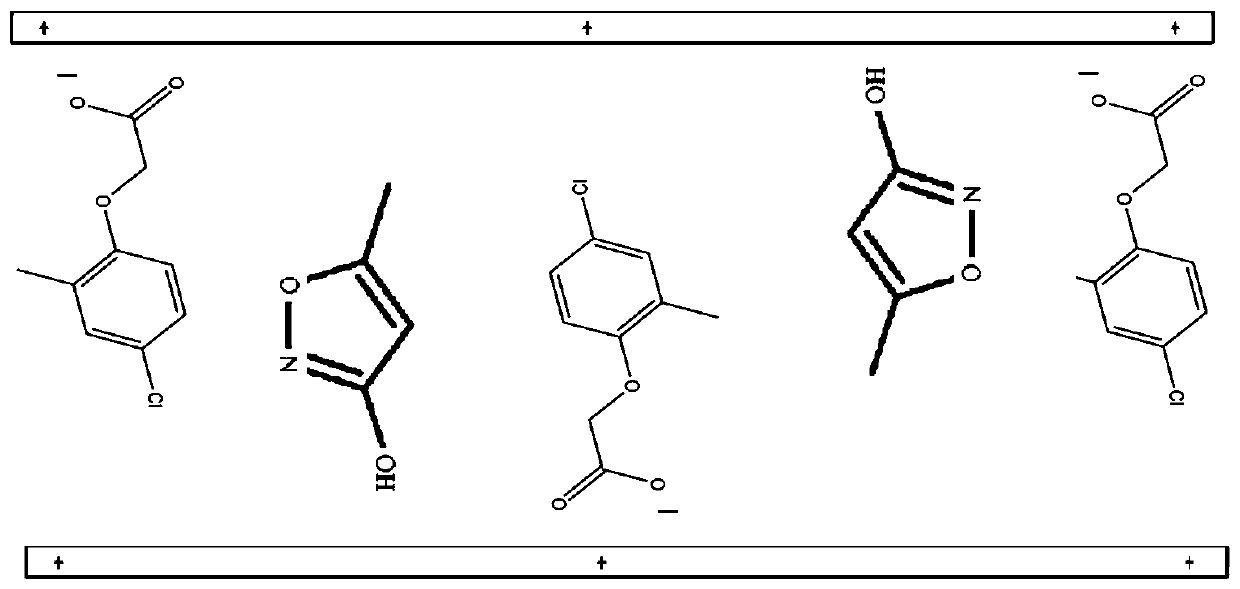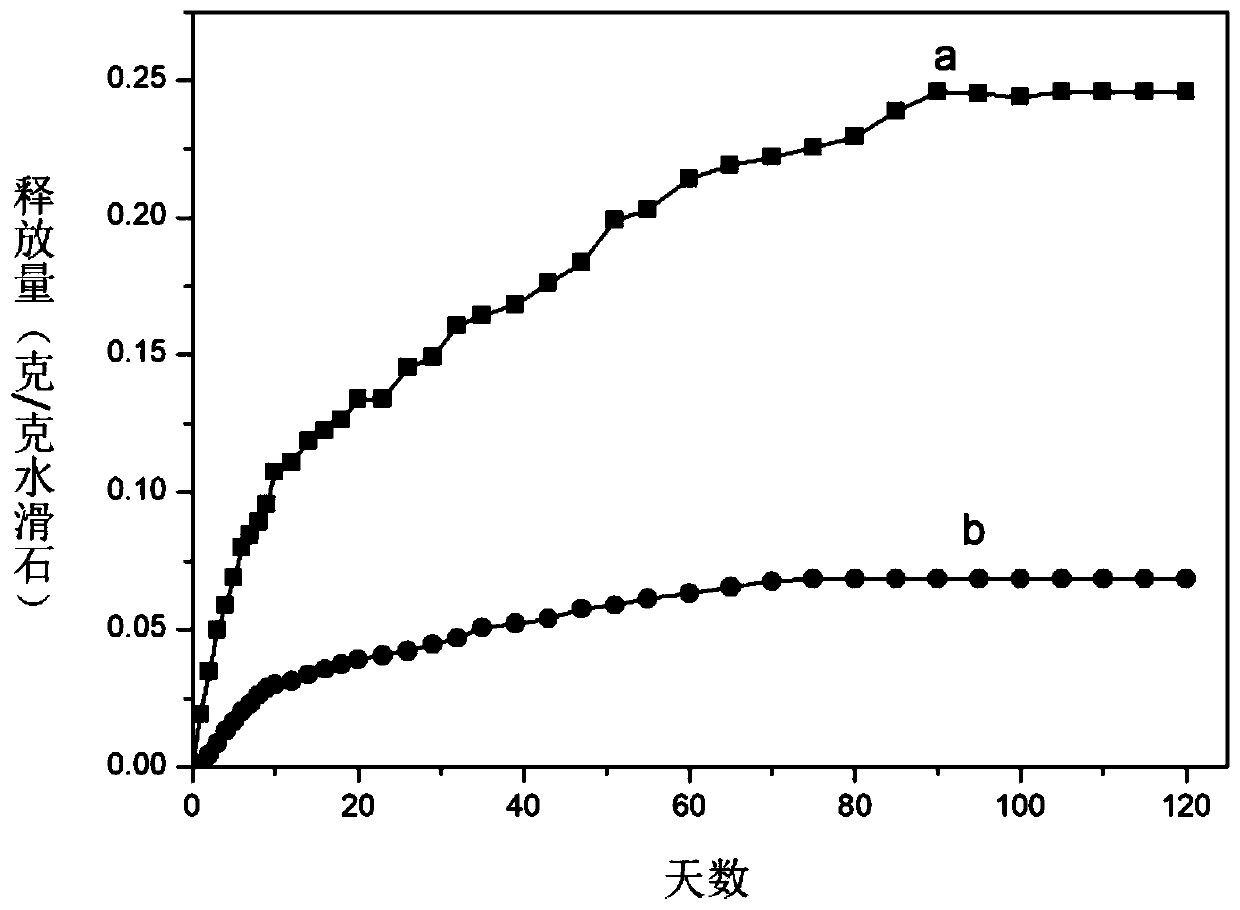Slow-release weeding and sterilizing double-effect pesticide and preparation method thereof
A slow-release, pesticide technology, applied to herbicides and algicides, botanical equipment and methods, fungicides, etc., to achieve high application value, strong interaction, and simple and easy preparation methods
- Summary
- Abstract
- Description
- Claims
- Application Information
AI Technical Summary
Problems solved by technology
Method used
Image
Examples
Embodiment 1
[0039] (1) Weigh 17.8g Zn(NO 3 ) 2 ﹒ 6H 2 O, 11.3g Al(NO 3 ) 3 ﹒ 9H 2 O dissolved in 100ml to remove CO 2 Mixed salt solution was prepared with water, another 5.6g NaOH was dissolved in 50ml to remove CO 2 Prepare alkaline solution in water, N at room temperature 2 Protection Use the double-drop method to add the salt solution and the alkali solution into the four-neck flask, and stir vigorously. Adjust the pH value to 7 with 0.1mol / L NaOH solution. The resulting slurry was crystallized at 60°C for 72 hours, and the product was placed in a centrifuge, centrifuged at a speed of 2500 rpm for 5 minutes, and then used to remove CO 2 Wash with water until neutral; take out the sample and dry it at 50°C for 48 hours for characterization, and obtain the hydrotalcite precursor ZnAl-NO 3 -LDHs, whose Zn 2+ / Al 3+ =2.
[0040] (2) 8.6g sodium tetrachloride [CH 3 (Cl)C 6 h 3 OCH 2 COONa] solid dissolved in 200mL to remove CO 2 After the deionized water was transferred ...
Embodiment 2
[0045] (1) Weigh 15.4g Mg(NO 3 ) 2 ﹒ 6H 2 O, 11.3g Al(NO 3 ) 3 ﹒ 9H 2 O dissolved in 100ml to remove CO 2 Mixed salt solution was prepared with water, another 2.0g NaOH was dissolved in 50ml to remove CO 2 Prepare alkaline solution in water, N at room temperature 2 The salt solution and the alkali solution were added into the four-necked bottle by the double drop method, and the pH value was adjusted to 10 with 5mol / L NaOH solution after the drop. Centrifuge at rpm for 3 min, then remove CO 2 Wash with water until neutral; take out a small amount of samples and dry them at 90°C for 20 hours for characterization to obtain the hydrotalcite precursor MgAl-NO 3 -LDHs, their Mg 2+ / Al 3+ =2.
[0046] (2) 8.6g sodium tetrachloride [CH 3 (Cl)C 6 h 3 OCH 2 COONa] solid dissolved in 200mL to remove CO 2 After the deionized water was transferred to the four-necked bottle, then add 10g of hydrotalcite precursor MgAl-NO 3 -LDHs,N 2 Protected and heated to 70°C, reacted...
Embodiment 3
[0051] (1) Weigh 17.4g Ni(NO 3 ) 2 ﹒ 6H 2 O, 11.3g Al(NO 3 ) 3 ﹒ 9H 2 O dissolved in 100ml to remove CO 2 Mixed salt solution was prepared with water, another 5.6g NaOH was dissolved in 50ml to remove CO 2 Prepare alkaline solution in water, N at room temperature 2 Protection Use the double-drop method to add the salt solution and the alkali solution into the four-neck flask, and stir vigorously. Adjust the pH value to 7 with 3.0mol / L NaOH solution. The resulting slurry was crystallized at 80°C for 30 h, and the product was placed in a centrifuge, centrifuged at a speed of 3000 rpm for 4 min, and then used to remove CO 2 Wash with water until neutral; take out the sample and dry it at 50°C for 48 hours for characterization, and obtain the hydrotalcite precursor NiAl-NO 3 -LDHs, whose Ni 2+ / Al 3+ =2.
[0052] (2) 8.6g sodium tetrachloride [CH 3 (Cl)C 6 h 3 OCH 2 COONa] solid dissolved in 200mL to remove CO 2 The deionized water was transferred to a four-neck...
PUM
 Login to View More
Login to View More Abstract
Description
Claims
Application Information
 Login to View More
Login to View More - R&D
- Intellectual Property
- Life Sciences
- Materials
- Tech Scout
- Unparalleled Data Quality
- Higher Quality Content
- 60% Fewer Hallucinations
Browse by: Latest US Patents, China's latest patents, Technical Efficacy Thesaurus, Application Domain, Technology Topic, Popular Technical Reports.
© 2025 PatSnap. All rights reserved.Legal|Privacy policy|Modern Slavery Act Transparency Statement|Sitemap|About US| Contact US: help@patsnap.com



